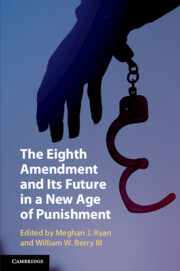Book contents
- The Eighth Amendment and Its Future in a New Age of Punishment
- The Eighth Amendment and Its Future in a New Age of Punishment
- Copyright page
- Dedication
- Contents
- Contributors
- Preface
- Introduction
- Part I A History of the Eighth Amendment
- 1 From the Founding to the Present
- 2 Back to the Future
- 3 Eighth Amendment Federalism
- Part II The Landscape of Eighth Amendment Doctrine
- Part III The Future of the Eighth Amendment
- Index
1 - From the Founding to the Present
An Overview of Legal Thought and the Eighth Amendment’s Evolution
from Part I - A History of the Eighth Amendment
Published online by Cambridge University Press: 03 June 2020
- The Eighth Amendment and Its Future in a New Age of Punishment
- The Eighth Amendment and Its Future in a New Age of Punishment
- Copyright page
- Dedication
- Contents
- Contributors
- Preface
- Introduction
- Part I A History of the Eighth Amendment
- 1 From the Founding to the Present
- 2 Back to the Future
- 3 Eighth Amendment Federalism
- Part II The Landscape of Eighth Amendment Doctrine
- Part III The Future of the Eighth Amendment
- Index
Summary
On June 8, 1789, James Madison — then a member of the U.S. House of Representatives — rose in the First Congress to propose a set of amendments to the recently ratified U.S. Constitution. “This day, Mr. Speaker,” he said, “is the day assigned for taking into consideration the subject of amendments to the constitution.” Some of his congressional colleagues thought the discussion premature, but Madison persisted, contending that “[t]he applications for amendments come from a very respectable number of our constituents, and it is certainly proper for Congress to consider the subject, in order to quiet that anxiety which prevails in the public mind.” Madison had sorted through nearly two hundred recommendations for constitutional amendments, and he wanted Congress to act promptly. “I hold it to be my duty to unfold my ideas, and explain myself to the House in some form or other without delay,” Madison stressed.
- Type
- Chapter
- Information
- Publisher: Cambridge University PressPrint publication year: 2020
- 1
- Cited by



